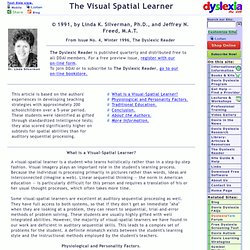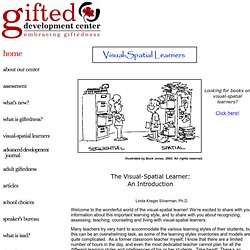

The Visual Spatial Learner. What is a Visual-Spatial Learner?

A visual-spatial learner is a student who learns holistically rather than in a step-by-step fashion. Visual imagery plays an important role in the student's learning process. Because the individual is processing primarily in pictures rather than words, ideas are interconnected (imagine a web). Linear sequential thinking — the norm in American education — is particularly difficult for this person and requires a translation of his or her usual thought processes, which often takes more time.
Some visual-spatial learners are excellent at auditory sequential processing as well. The visual (spatial) learning style. If you use the visual style, you prefer using images, pictures, colors, and maps to organize information and communicate with others.

You can easily visualize objects, plans and outcomes in your mind's eye. You also have a good spatial sense, which gives you a good sense of direction. You can easily find your way around using maps, and you rarely get lost. Visual-Spatial Learners. Linda Kreger Silverman.

Ph.D. Welcome to the wonderful world of the visual-spatial learner! We’re excited to share with you information about this important learning style, and to share with you about recognizing, assessing, teaching, counseling and living with visual-spatial learners. Many teachers try very hard to accommodate the various learning styles of their students, but this can be an overwhelming task, as some of the learning styles inventories and models are quite complicated.
As a former classroom teacher myself, I know that there are a limited number of hours in the day, and even the most dedicated teacher cannot plan for all the different learning styles and intelligences of his or her students.